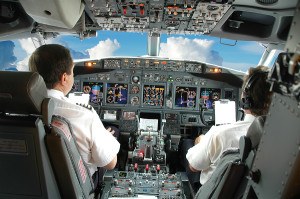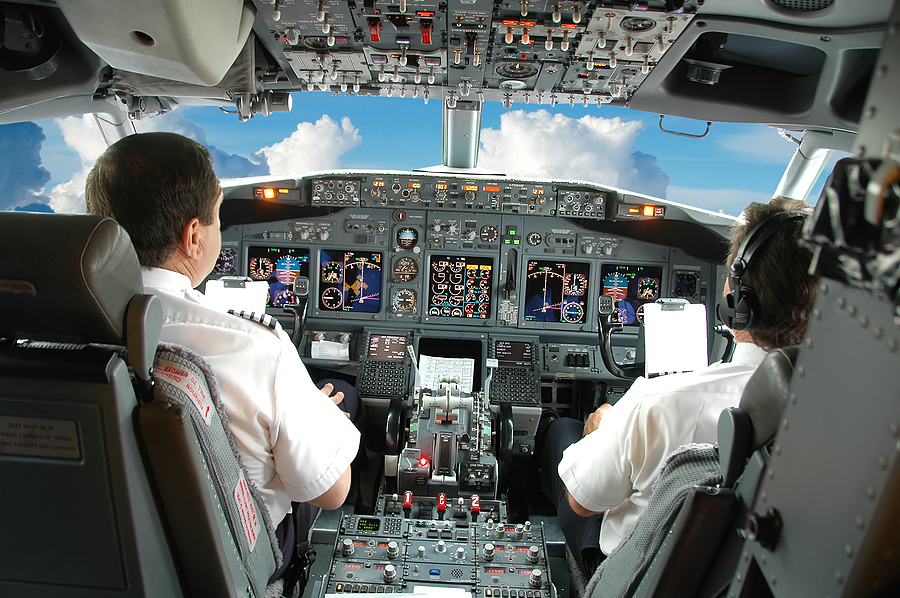Airline pilots have lost flying skills as automation takes over mundane tasks and may be startled when systems don’t behave as expected, both of which have contributed to crashes, a U.S. government and industry report concluded.
Airlines need to improve pilot training in autopilots and other automation in the cockpit, the report obtained by Bloomberg News said.
The issue is growing in importance as the U.S. installs the $42-billion satellite-based navigation system known as NextGen, the report found. The report was commissioned by the Federal Aviation Administration.
“There are times when the airplane will do something that’s unexpected and the pilots will go, ‘Why did it just do that?’” Patrick Veillette, a corporate pilot who wrote his Ph.D. thesis on cockpit automation, said in an interview.
 Auto-throttles, computer navigation systems and other automation on planes have improved safety, said Veillette, who didn’t participate in the report. Airline safety is at an all- time high, according to accident statistics.
Auto-throttles, computer navigation systems and other automation on planes have improved safety, said Veillette, who didn’t participate in the report. Airline safety is at an all- time high, according to accident statistics.
The downside of these new technologies is that they may be incorrectly programmed more than previous systems and are so complex that pilots don’t always understand their actions, Veillette said.
The report’s findings were reported earlier in the Wall Street Journal.
Recent Accidents
The report, entitled “Operational Use of Flight Path Management Systems,” said it studied 26 accidents from 1996 to 2009 in which automation played a role. The authors also relied on incident reports, cockpit audits and anonymous pilot accounts gathered by airlines and government agencies.
Several recent accidents that weren’t considered in the report, including the Feb. 12, 2009, crash of a regional turboprop approaching Buffalo operated by Pinnacle Airlines Corp.’s former Colgan unit, are also related to how pilots are trained on cockpit automation, Veillette said. The Colgan accident killed all 49 on the plane and a man on the ground.
A pilot on an Asiana Airlines plane that struck a seawall while attempting to land in San Francisco July 6 said he thought the plane’s auto throttle was maintaining speed, National Transportation Safety Board Chairman Deborah Hersman said after the accident.
The Boeing Co. 777 had slowed to almost 40 miles (64 kilometers) per hour below its target speed before losing altitude and striking the seawall, Hersman said. The NTSB hasn’t yet concluded what caused the accident.
‘Failure Situations’
Pilots accustomed to having autopilots and other devices to keep a plane on course and at the correct speed have allowed basic manual skills to erode, the report said.
Pilots also have greater difficulty handling malfunctions of automated systems because they may not understand the systems or haven’t been adequately trained, it concluded.
“This is a particular concern for failure situations which do not have procedures or checklists, or where the procedures or checklists do not completely apply,” it said.
In other cases, pilots have accidentally put the wrong information into an airplane’s guidance system, leading to flying the wrong path or even accidents, according to the report.
The report included 18 recommendations for better training on how cockpit devices work, improved design of the systems and new procedures to minimize the impact of malfunctions or mistakes.
The FAA, starting when the group that wrote the report began its work in 2006, has taken action on the 18 recommendations, it said in an e-mail statement.
The agency on Feb. 5 issued new regulations changing pilot training to emphasize more realistic simulator sessions. That action addresses several of the report’s recommendations.
FAA Administrator Michael Huerta has called industry officials to a meeting Nov. 21 to discuss additional steps the airlines can take to voluntarily improve training, according to the e-mail.
(Editors: Bernard Kohn, Elizabeth Wasserman)
Was this article valuable?
Here are more articles you may enjoy.


 Allstate Thinking Outside the Cubicle With Flexible Workspaces
Allstate Thinking Outside the Cubicle With Flexible Workspaces  Indian News Agency Sues OpenAI for Copyright Violation
Indian News Agency Sues OpenAI for Copyright Violation  T-Mobile Caught Hackers Early, Averting Data Leak
T-Mobile Caught Hackers Early, Averting Data Leak  Allstate Insurers Sue Hyundai, Kia to Pay for Claims From Defective Cars
Allstate Insurers Sue Hyundai, Kia to Pay for Claims From Defective Cars 